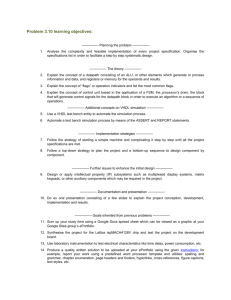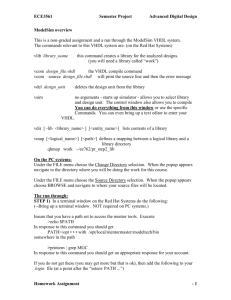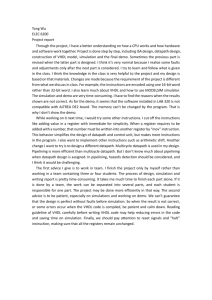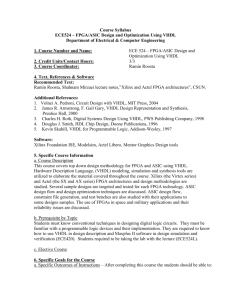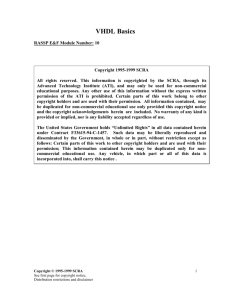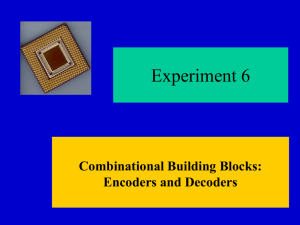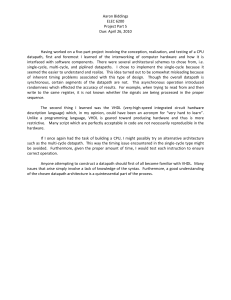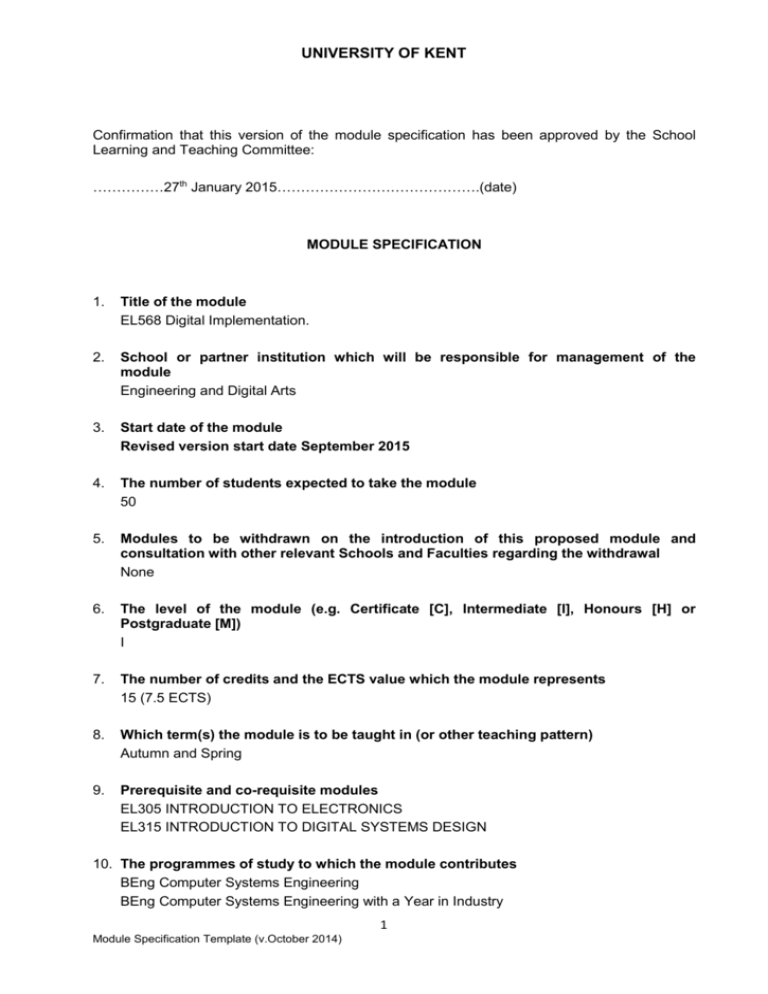
UNIVERSITY OF KENT
Confirmation that this version of the module specification has been approved by the School
Learning and Teaching Committee:
……………27th January 2015…………………………………….(date)
MODULE SPECIFICATION
1.
Title of the module
EL568 Digital Implementation.
2.
School or partner institution which will be responsible for management of the
module
Engineering and Digital Arts
3.
Start date of the module
Revised version start date September 2015
4.
The number of students expected to take the module
50
5.
Modules to be withdrawn on the introduction of this proposed module and
consultation with other relevant Schools and Faculties regarding the withdrawal
None
6.
The level of the module (e.g. Certificate [C], Intermediate [I], Honours [H] or
Postgraduate [M])
I
7.
The number of credits and the ECTS value which the module represents
15 (7.5 ECTS)
8.
Which term(s) the module is to be taught in (or other teaching pattern)
Autumn and Spring
9.
Prerequisite and co-requisite modules
EL305 INTRODUCTION TO ELECTRONICS
EL315 INTRODUCTION TO DIGITAL SYSTEMS DESIGN
10. The programmes of study to which the module contributes
BEng Computer Systems Engineering
BEng Computer Systems Engineering with a Year in Industry
1
Module Specification Template (v.October 2014)
UNIVERSITY OF KENT
BEng Electronic and Communications Engineering
BEng Electronic and Communications Engineering with a Year in Industry
MEng in Computer Systems Engineering
MEng in Computer Systems Engineering with a Year in Industry
MEng Electronic and Communications Engineering
MEng Electronic and Communications Engineering with a Year in Industry
11. The intended subject specific learning outcomes
On successful completion of the module, students will have:
1. The necessary skills to model digital components using VHDL;
2. An understanding of the operation of CMOS Digital ICs and Memories;
3. Necessary skills to design Memory Address decoder systems;
4. An understanding of the operation and implementation of a modern CPU.
These outcomes are related to the programme learning outcomes in the appropriate
curriculum maps as follows:
ECE/ECEwInd: A2,A3,A5,A8,B1,B3-5,C1,C2,C4,C5,C8
CSE/CSEwInd: A2,A3,A5,A8,B1,B3-5,C1,C2,C4,C6,C9
12. The intended generic learning outcomes
On successful completion of this module students will be able to
1) use ICT,
2) apply critical thinking
3) manage time effectively.
These outcomes are related to the program learning outcomes in the appropriate
curriculum maps as follows:
ECE/ECEwInd: D1,D5,D6,D7
CSE/CSEwInd: D1,D5,D6,D7
13. A synopsis of the curriculum
Lecture Syllabus
AN INTRODUCTION TO VHDL
This course introduces the hardware description language, VHDL. A subset of the VHDL
language is introduced, which enables moderately complex behavioural and structural
models of digital components to be developed. Practical work associated with this course is
performed using a Windows-based VHDL compiler and simulator. The Workshops
complement the lecture material and provide students with the necessary skills to enable
them to use VHDL in their third year projects.
DIGITAL SYSTEM IMPLEMENTATION
Real Logic Gates: voltage and current characteristics, noise immunity and fanout. The MOS
Transistor - detailed operation. Introduction to Stick diagrams.
CMOS Logic Gates. Clocked Logic. Registers, Shift registers.
MEMORY INTERFACING
2
Module Specification Template (v.October 2014)
UNIVERSITY OF KENT
Structure of Read/Write and Read Only memory cells. Storage mechanisms in Read Only
Memories,
Static and Dynamic RAMs. DRAM Cell Design - 3 transistor and 1 transistor, row & column
decoders. Memory Read and Write Cycles. Memory Addressing. Multiplexed Addressing.
Address decoding, Memory system implementation, Processor-Memory Interfacing.
Structure and operation of a small memory system based on RAM devices.
Coursework
EXPERIMENT: (CAD1 Introduction to VHDL Design). 2 days. Assessed.
WORKSHOPS: INTRODUCTION TO VHDL, Six, 2-hour workshops on VHDL/Xilinx, Two of
these workshops are assessed.
EXAMPLES CLASS: DIGITAL SYSTEM IMPLEMENTATION
A one-hour examples class. Assessed.
EXAMPLES CLASS: MEMORY INTERFACING
A one-hour examples class. Assessed.
14. Indicative Reading List
Core Text
Rushton, A (2011) VHDL for logic synthesis, Wiley-Blackwell, Oxford
Recommended Reading
Mark Zwolinksi (2004) Digital System Design with VHDL, Pearson/Prentice Hall Harlow
Roth, Charles H., John, Lizy Kurian (c2008) Digital systems design using VHDL. Thomson,
London, Toronto, Ontario.
Digital Design, Mano, Prentice-Hall
Pucknell, Douglas A., Eshraghian, Kamran (1994) Basic VLSI Design, Prentice-Hall,
London, New York
Kaeslin, Hubert (c2008) Digital integrated circuit design: from VLSI architectures to CMOS
fabrication, Cambridge University Press, Cambridge.
Ayers, JE (c2010) Digital integrated circuits: analysis and design, CRC, Boca Raton, Fla,
London.
Kishore, K. Lal, Prabhakar, V.S.V. (2009) VLSI Design, I K International Publishing House
Pvt. Ltd, New Delhi
Das, Debaprasad (2010) VLSI Design, Oxford University Press, New Delhi
Baker, JR (2010) CMOS: circuit design, layout, and simulation, Wiley-IEEE Press,
Hoboken, NJ.
Pedroni, Volnei A. (2008) Digital electronics and design with VHDL, Elsevier Science
[distributor], Morgan Kaufmann, Oxford, San Francisco, Calif
Salemi, R (c2009) FPGA simulation: a complete step-by-step guide
Amos, Doug, Lesea, Austin, Richter, Rene (2011) FPGA-based Prototyping Methodology
Manual: Best Practices in Design-for-Prototyping, Synopsys Press.
Arora, Mohit (2012) The art of hardware architecture: design methods and techniques for
digital circuits, Springer, New York.
3
Module Specification Template (v.October 2014)
UNIVERSITY OF KENT
15. Learning and Teaching Methods, including the nature and number of contact hours
and the total study hours which will be expected of students, and how these relate to
achievement of the intended module learning outcomes
There will be 28 hours of lectures, 18 hours of experimental work, 12 hours of workshops
and 2 hours of examples classes.
The Introduction to VHDL lecture course and examples class delivers learning outcome
11.1, as do the workshops and experiment.
Learning outcomes 11.2 and 11.4 are delivered through the Digital System Implementation
course.
The Memory interfacing course and examples class will deliver learning outcomes 11.3 and
11.4.
Generic learning outcomes 12.1-12.3 are addressed by the experiment and the workshops.
Total Contact Hours:
Independent Study Hours:
Total Study Hours:
58
92
150
16. Assessment methods and how these relate to testing achievement of the intended
module learning outcomes
Learning outcome 11.1 is assessed through the Laboratory experiment and the Introduction
to VHDL and Xilinx workshops. The Digital System Implementation examples class
assesses learning outcome 11.2. The examination assesses learning outcomes 11.2, 11.3,
11.4. Weighting between coursework and the examination is 40:60. The examination
duration is 2 hours.
The coursework mark is proportioned as follows:
CAD 1 Introduction to VHDL design experiment (45%)
Introduction to VHDL and Xilinx 2 assessed workshops (20%)
The Digital System Implementation examples class (15%)
Memory Interfacing examples class (20%)
The generic learning outcomes 12.1 to 12.3 are assessed by the experiment and
workshops.
In order to obtain credit for this module, the coursework mark and the exam mark must
each be greater than or equal to 30% as well as achieving the pass mark for the module.
This module will only be considered for compensation if the coursework mark and exam
mark are each greater than 30%
17. Implications for learning resources, including staff, library, IT and space
None
18. The School recognises and has embedded the expectations of current disability
equality legislation, and supports students with a declared disability or special
4
Module Specification Template (v.October 2014)
UNIVERSITY OF KENT
educational need in its teaching. Within this module we will make reasonable
adjustments wherever necessary, including additional or substitute materials,
teaching modes or assessment methods for students who have declared and
discussed their learning support needs. Arrangements for students with declared
disabilities will be made on an individual basis, in consultation with the University’s
disability/dyslexia support service, and specialist support will be provided where
needed.
19. Campus(es) or Centre(s) where module will be delivered:
Canterbury
5
Module Specification Template (v.October 2014)

